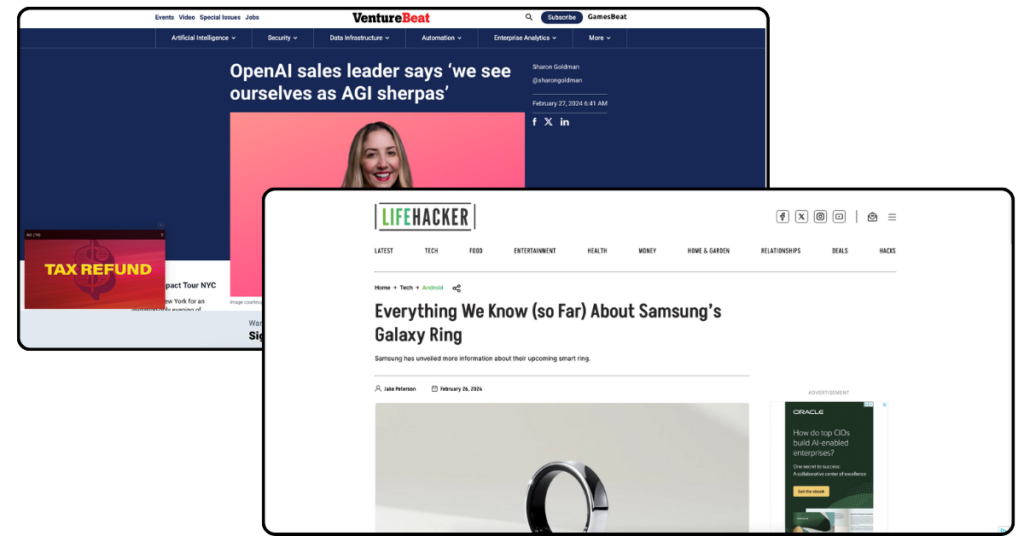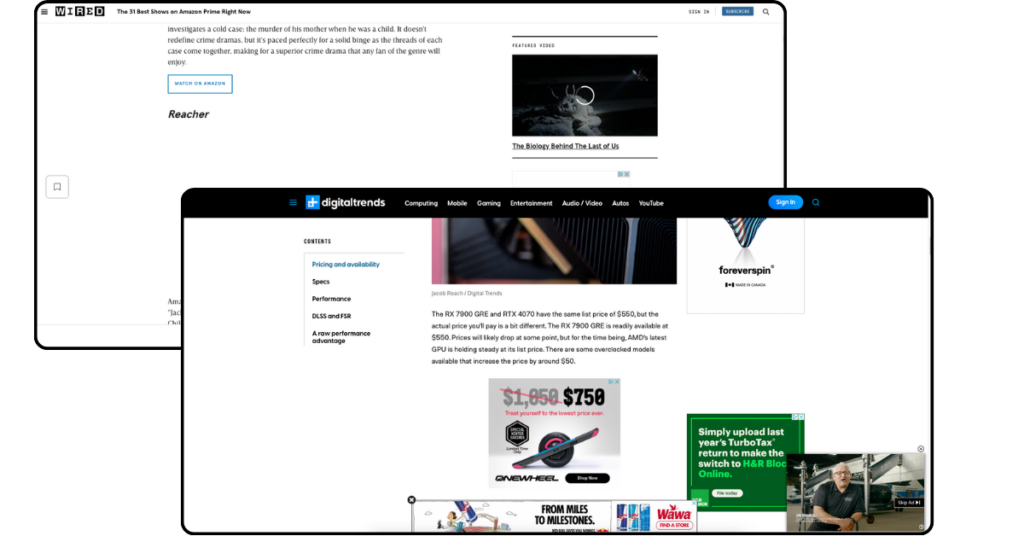The Open Internet, or the Open-ish Internet?
🚨 BREAKING 🚨: Third-party cookies are going away. Have you heard?
There are so many hot takes on the situation you’re bound to get a tan.
Most fall into one of these camps:
| Cookie deprecation isn’t new. | It’s only new to Chrome. We haven’t had cookies in iOS since 2017. No biggie. |
| Chrome has a high market share, so it IS a biggie. | But don’t worry, solutions are on the way. Google’s Privacy Sandbox solves for various marketing use cases. |
| Are you kidding? | We are going to trust Google to develop a solution that allows the rest of the ad industry to compete fairly??? |
| First-party cookies are vibranium. | Walled Gardens have abundant supply, but publishers with their own vibranium will survive in this new world. |
| Identity solutions like UID 2.0 will save us all. | Whew. |
| Cookiepocalypse. | People almost never log in on the web, so first-party cookies and identity solutions aren’t going to get it done. We need to do something different. |
Those in the sixth stage of cookie grief are taking action, trying to figure out what that “something different” is.
So, What are Buyers Doing About It?
Now that cookie deprecation is finally, finally happening, ad buyers are testing out new approaches.
One trend we love: more buyers are focusing on the QUALITY of their ad inventory.
One trend we don’t love: in an attempt to focus on “quality,” some are cutting out the long tail of the open internet (and the whole middle part, too).
Those using this approach are doing so for one of two reasons:
- They believe that the biggest sites are the best. OR
- It’s a shrug solution: “I don’t know how to deal with the long tail, so I’m just not going to deal with the long tail.”

But:
- Bigger is not always better.
- Long-tail sites attract valuable audiences engaged in topics they care about deeply.
Why Bigger Is Not Always Better
One inventory strategy gaining traction is to focus solely on the “Top 500” or “Top 1000” publishers.
The thought is these publishers guarantee brand safety and deliver content with broad appeal.
After all, if a publisher has gotten this big, they must be doing something right. Right?
Three examples of why this is a flawed argument:
1. Playing the Search Game
Publisher HouseFresh recently dropped an excellent post, sharing instances of large publishers flooding search engines with low-value review content.
Their investigation found Popular Science and Buzzfeed jamming through regurgitated and misleading content to get top rankings in search.
People click on these publishers’ search listings because they recognize and trust the publisher name.

“These Digital Goliaths are utilizing their websites’ authority and the public’s trust in their brands to sell every product under the sun.
They’re buying magazines we love, closing their print operations, turning them into digital-only, laying off the actual journalists who made us trust in their content in the first place, and hiring third-party companies to run the affiliate arm of their sites.”
Ok, but why does this matter for advertisers?
Brand Keys’ 2022 “Marketing on My Mind” survey asked 407 CMOs and brand managers, “What issues keep you up at night?”
90% of respondents said, “establishing trust between my brand and the consumer.”
Well, if you’re running your digital ads on websites that erode consumer trust, you risk guilt by association.
Does this website sound trustworthy:
Website claim: they “tested 67 air purifiers in their lab in Des Moines, Iowa.”
Website recommendation: buy the air purifier from a company that “filed for bankruptcy, has active class action lawsuits for false advertising, and [was] recognized by Wirecutter as the worst air purifier they tested.”

2. The AI Revolution, or the AI Devolution?
Sports Illustrated blasted out a ton of AI-generated content to get more pageviews and ad dollars.
Publishers like Gizmodo and The A.V. Club are leaning heavily into AI-generated content, and CNET in particular was found “publishing barely-disclosed AI content that was filled with factual mistakes and even plagiarism.”

Low-trust, AI-fueled content is mistakenly considered a risk solely for the long tail.
However, big-name publishers often have demanding investors and C-level executives who are pressured to hit the next set of quarterly targets.
When these prominent publishers sacrifice their long-term values for short-term gains, it shouldn’t be such a shocking surprise.
3. Made For Advertising: A Subset of the Larger Problem
The term “made for advertising,” or MFA, refers to websites that primarily exist to generate revenue through advertising, often at the expense of user experience and content quality.
Why do MFA sites get so much hate?
- They’re terrible for users. Too many ads calling too many third parties, and the user has to wait for the page to load each time they scroll. Incredibly frustrating experience to sit through.
- They’re terrible for advertisers. Whether it’s the ads not being seen (dozens of ads stacked below the fold, collecting ad dollars), or the ads loading five at a time on screen, both situations stink.
Guess what? These problems are not limited to the MFA boogeymen. Well-known sites engage in these practices, too. Yet, the industry doesn’t label these sites as MFA 🤔

To understand how user experiences can differ across sites large and small, we’ll focus on the tech vertical.
Large Technology Sites
As with all verticals, some Top 1000-type sites are going to be great.
Venturebeat.com and lifehacker.com are two tech sites that score an A for their overall user experience.

On average, VentureBeat takes 0.6 seconds to load above the fold and has all its content “fully loaded” in 5 seconds, both excellent results.
Pages loading this fast are pleasing for users and offer more time in focus for brands running there.
Compare that to two other familiar tech names that don’t fare as well: wired.com and digitaltrends.com – they scored a D and an F for overall user experience, respectively.

Wired.com’s average page fully loaded time is 18.5 seconds, and digitaltrends.com’s is 59.4 seconds (!)
Both sites fall short on several other user-impacting metrics. For instance, Digital Trends generates 711 requests, which is considerably high.
These requests encompass a wide range of activities, including loading images, fonts, and HTML, but a significant portion stem from serving ads and analytics/tracking scripts.
Long-Tail Technology Sites
If you cut out the long tail, you cut out sites like techrepublic.com and hackaday.com, both excellent tech websites with clean layouts and engaging, original content.

Both sites are great for users, each scoring an A for their overall user experience.
Techrepublic.com takes a mere 5.6 seconds to fully load, and uses a reasonable 32% of your computer’s CPU during that load. Resource-intensive sites can clock in at 50-60%+.
The simple eye test gives you an idea: most pages on TechRepublic load swiftly, without any content shifts or awkward scrolling.
You’ll also see the articles have four ads in tasteful locations, including one in a sticky placement on the left rail, a pretty eye-catching spot.
Take that, banner blindness.

Now, all of that sounds great, and sure, some long-tail sites are sharply designed and a delight to use.
But is the “open internet” really a thing? Are people visiting these niche sites?
A Tale of the Tail
Let’s explore one tiny strand of the long tail.
I’ll choose a nerdy card game (that I happen to dabble in myself): Magic: the Gathering.
Of course, some of you won’t have any idea what Magic is. Some of you may have heard of it in passing or even played it in middle school (the game did turn 30 years old in 2023, after all).

But very few of you likely play it now, let alone are engrossed enough in the hobby to consume content related to Magic on a regular basis.
What is it, exactly? Short version: Magic: the Gathering is a card game where you take a set amount of cards and create a “deck” to use against other players.
This hobby, like many hobbies, is not what would be considered “mainstream.” If we look at a list of top sites that Magic enthusiasts visit, none of them are Top 1000, all easily falling into the long tail:
| Site | Tranco Rank |
|---|---|
| MTGGoldfish | 11,456 |
| EDHREC | 14,440 |
| Card Kingdom | 26,315 |
| Quiet Speculation | 1,638,314 |
| DraftSim | 125,450 |
| Wizards of the Coast | 2,868 |
| Channel Fireball | 206,417 |
| MTG Salvation | 133,371 |
| MTG Decks | 66,905 |
| Moxfield | 23,200 |
You won’t get any of these sites if your targeting strategy focuses on a Top 1000 approach.
Does that matter?
These sites have such a low traffic ranking that people can’t actually be spending time there, right? And is this even a valuable audience to reach?
Estimates suggest Magic has around 40 million players worldwide.

In January 2024 alone, over 2.4 million hours of Magic-related content was watched on Twitch.
And Magic’s revenue for the full year of 2022 was up 7% to $1.0652 billion. Billion with a B.
Maybe worth making sure we don’t lop off the long tail and leave out niche passion communities like this one?
Otherwise, your ad strategy will miss out on pickleball enthusiasts, drone racers, and participants in bed-making contests:
Objectivity is the Objective
Managing quality and safety across the sheer scale of the open internet is a challenge, to be sure. This is especially true when we rely on subjective criteria and manual efforts to curate the perfect inventory mix.
We can evaluate inventory at scale by shifting our decisioning to more objective criteria. Tangible metrics like engagement, content integrity, and user experience put all sites on a level playing field.
Then, the websites with the worst user and ad experiences don’t get a free pass, regardless of their traffic size.
A metrics-based approach helps us deliver a better ad experience for both users and our brands.
Interested in learning more about UX metrics? Give us a shout here:
Open Door Policy
It’s surprising to hear certain ad tech firms champion the open internet in one breath, only to propose slicing a massive chunk of it out the next.
That kind of blunt-forced policy ignores the nuanced reality: not all Top 1000 sites are flawless, and the long tail is far from valueless.
You can’t have an open internet while slamming the door shut on the vibrant, niche communities of the long tail.
Sometimes your prospective customers will be checking the forecast on one of the weather mega-publishers, and sometimes your customers will be looking up strategies for their Atraxa Commander Magic deck.
